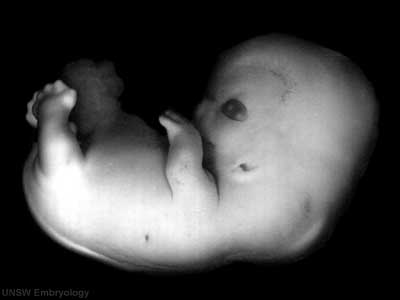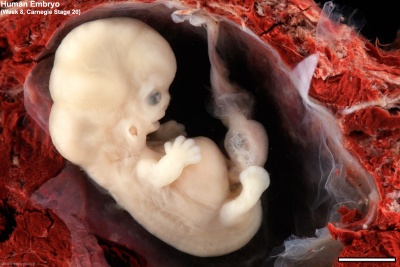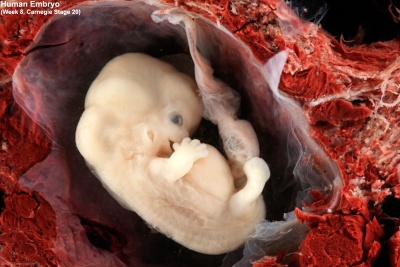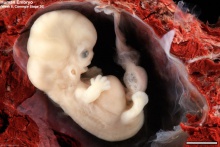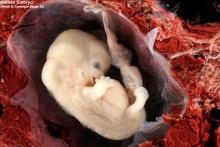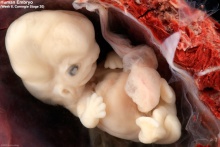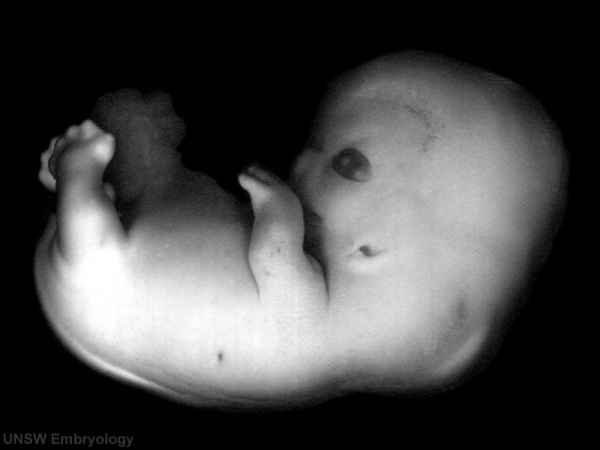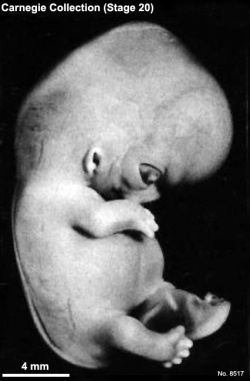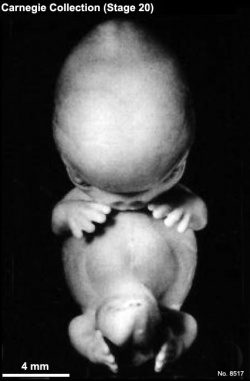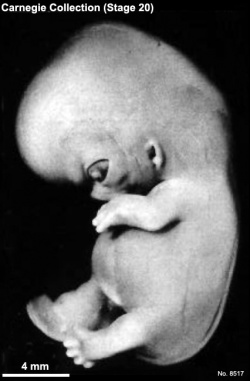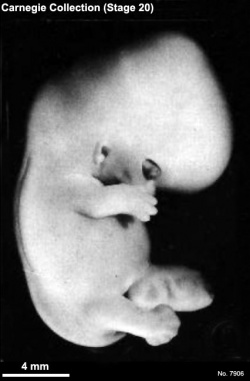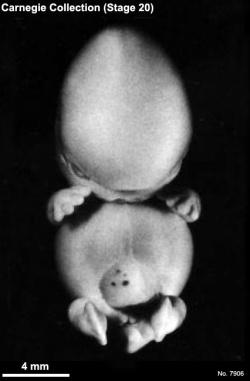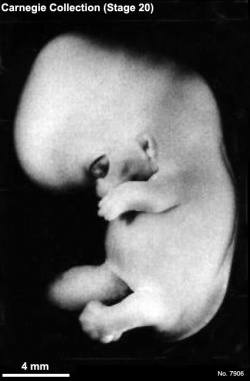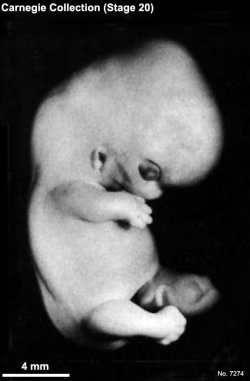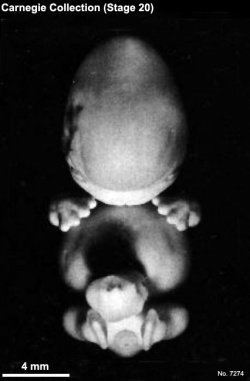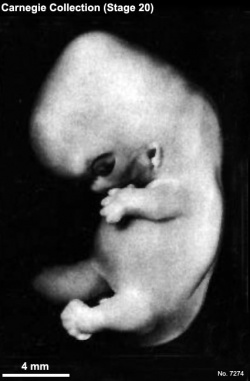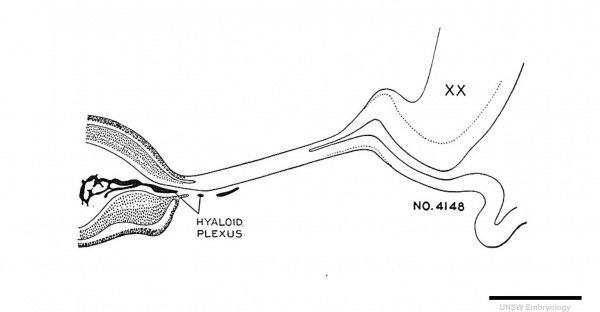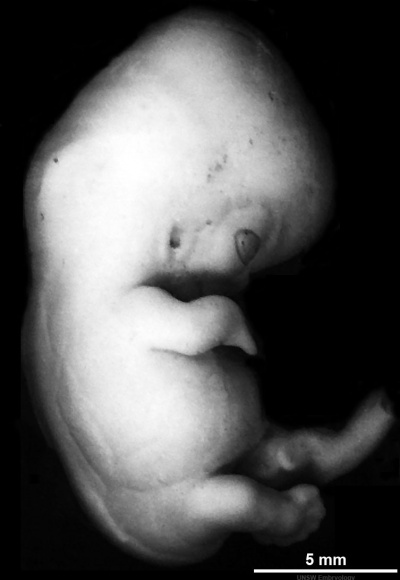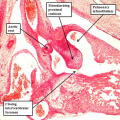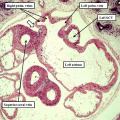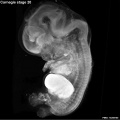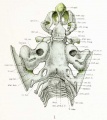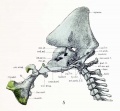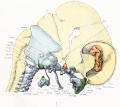Carnegie stage 20
| Embryology - 27 Jun 2024 |
|---|
| Google Translate - select your language from the list shown below (this will open a new external page) |
|
العربية | català | 中文 | 中國傳統的 | français | Deutsche | עִברִית | हिंदी | bahasa Indonesia | italiano | 日本語 | 한국어 | မြန်မာ | Pilipino | Polskie | português | ਪੰਜਾਬੀ ਦੇ | Română | русский | Español | Swahili | Svensk | ไทย | Türkçe | اردو | ייִדיש | Tiếng Việt These external translations are automated and may not be accurate. (More? About Translations) |
Introduction
Facts
Week 8, 51 - 53 days, 18 - 22 mm
Gestational age GA week 10
Summary
- Ectoderm: sensory placodes, lens pit, otocyst, nasal pits moved ventrally, fourth ventricle of brain
- Mesoderm: heart prominence, ossification continues
- Head: forebrain, eye, external acoustic meatus
- hearing - otic capsule connected with the basal plate and with the future exoccipitals. Tip of the cochlea is elongated and curled. Tensor tympani and stapedius present.
See also Carnegie stage 20 Events
Features
- scalp vascular plexus, eylid, eye, nose, external acoustic meatus, auricle of external ear, arm, elbow, wrist, liver prominence, digital rays
- Identify: straightening of trunk, pigmented eye, eyelid, nose, external acoustic meatus, scalp vascular plexus, digital rays, liver prominance, thigh, ankle, foot plate, umbilical cord
| Week: | 1 | 2 | 3 | 4 | 5 | 6 | 7 | 8 |
| Carnegie stage: | 1 2 3 4 | 5 6 | 7 8 9 | 10 11 12 13 | 14 15 | 16 17 | 18 19 | 20 21 22 23 |
- Carnegie Stages: 1 | 2 | 3 | 4 | 5 | 6 | 7 | 8 | 9 | 10 | 11 | 12 | 13 | 14 | 15 | 16 | 17 | 18 | 19 | 20 | 21 | 22 | 23 | About Stages | Timeline
Bright Field
Virtual Embryo Slides
|
|
|
Kyoto Collection
View: This is a dorsolateral view of embryo. Amniotic membrane removed.
K10344
K15818
- Sagittal Histology
Movies
|
|
Image source: The Kyoto Collection images are reproduced with the permission of Prof. Kohei Shiota and Prof. Shigehito Yamada, Anatomy and Developmental Biology, Kyoto University Graduate School of Medicine, Kyoto, Japan for educational purposes only and cannot be reproduced electronically or in writing without permission.
Carnegie Collection
- Carnegie stage 20: 8517 Right | 8517 Anterior | 8517 Left | 7906 Right | 7906 Anterior | 7906 Left | 7274 Right | 7274 Anterior | 7274 Left
| Carnegie Collection - Stage 20 | |||||||||||
|---|---|---|---|---|---|---|---|---|---|---|---|
| Serial No. | Size (mm) | Grade | Fixative | Embedding Medium | Plane | Thinness (µm) | Stain | Point Score | Sex | Year | Notes |
| 240 | E, 20 Ch, 50x40x30 | Poor | Formalin | P | Coronal | 20 | Iron H. | 27 | d | 19?? | |
| 256 | E, 21 | poor | Alc | p | Sagittal | 25 | Coch. | 23 | M | 1904 | Tubal. Partial anencephaly |
| 353 | E, 20 | Poor | Alc | P | Sagittal | 20 | H. & Congo red | 22,5 | M | 1906 | |
| 431 | E, 19 Ch, 30x25x25 | Good | Formalin | P | Sagittal | 20 | H. & Congo red | 25,5 | M | 1908 | Tubal |
| 437 | E, 23 Ch., 80x60x50 | Poor | Formalin | P | Sagittal | 50 | Coch | 24 | M | 193? | |
| 453 | E, 23 Ch, 60x40x30 | Poor | Formalin | P | Sagittal | 20 | H. & Congo red | 23-5 | ? | 1910 | Injected |
| 460 | E, 21 | Exc. | Bichlor. acetic | P | Transverse | 40 | (Stain - Haematoxylin Eosin), coch, | 24.5 | M | 1910 | injected |
| 462 | E, 20 Ch, 50x40x30 | Exc. | Formalin | P | Transverse | 40 | Al, coch | 23.5 | F | 1910 | |
| 635B | E, 22 | Poor | Alc | P | Transverse | 50 | Al, coch | 26.5 | M | 1913 | |
| 657 | E, 25 Ch, 35x20x15 | Poor | Formalin | C | Sagittal | 40 | Al, coch | 26.5 | M | 1913 | Tubal |
| 966 | E, 23 Ch, 51x38x13 | Exc | Bichlor. acetic | P | Coronal | 40 | (Stain - Haematoxylin Eosin), aur, or. G | 25 | M | 1911 | Tubal |
| 1134B | E, 23 | Poor | Formalin | p | Sagittal | 100 | Al. coch., | 22 | - | 1915 | |
| 1266 | E, 23.1 | Poor | Formalin | C-P | Sagittal | 25 | Al. coch., (Stain - Haematoxylin Eosin) aur, or G | 20.5 | F | 191? | |
| 2393 | Ch, 61.5x50x35 | Poor | |||||||||
| 3527 | E., 22 Ch. 32x30x10 | Good | Formalin | P | Sagittal | 25 | Al. coch., | 28 | ? | 1921 | |
| 4059 | E, 21.6 | Good | Formalin | P | Coronal | 15 | Al. coch., Mallory | 29.5 | $ | 1922 | |
| 4148 | E, 21 Ch. 45x34x30 | Good | Formalin | p | Coronal | 15 | A1. coch., Mallory | 19 | ? | 1922 | |
| 4361 | E, 22 Ch., 52x42x23 | poor | Formalin | 9 | Transverse | 20 | Coch. | 24 | 8 | 1923 | |
| 6202 | E, 21 Ch., 35x35x22 | Exc | Bouin | P | Sagittal | 20 | (Stain - Haematoxylin Eosin) | 20.5 | 8 | 1930 | Tubal |
| 6426 | E 21.5 | Good | Formalin | C—P | Transverse | 20 | (Stain - Haematoxylin Eosin) | 21 | 3 | 1931 | |
| 7274 | E, 18.5 Ch., 48x44x35 | Exc | Bouin | C—P | Transverse | 20 | (Stain - Haematoxylin Eosin), phlox. | 20 | M | 1936 | |
| 7906 | E19.5 | Exc | Bouin | C—P | Coronal | 20 | (Stain - Haematoxylin Eosin) | 22 | 8 | 1941 | Left renal agenesis |
| 8517 | E., 20.8 | Exc. | Bouin | C—P | Coronal | 20 | (Stain - Haematoxylin Eosin) | 24 | 8 | 1943 | |
| 8226 | E, 18.0 | Exc. | Bouin | C—P | Sagittal | 10 | Alan | ? | 3 | 1944 | |
Abbreviations
| |||||||||||
| iBook - Carnegie Embryos | |
|---|---|
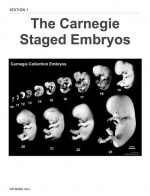
|
|
Blechschmidt Collection
Embryo (130758)
- Links: Blechschmidt Collection
Hinrichsen Collection
Embryo 335 Carnegie stage 20, CRL 22 mm, Frontal horizontal, Stains (HE, Tri, Azan), Slides 270.
Digital Embryology Consortium - Hinrichsen Collection
Image source: The Hinrichsen Collection images are reproduced with the permission of Prof. Beate Brand-Saberi, Head, Department of Anatomy and Molecular Embryology, Ruhr-Universität Bochum. Images are for educational purposes only and cannot be reproduced electronically or in writing without permission.
Madrid Collection
| Madrid Collection Embryos | ||||||
|---|---|---|---|---|---|---|
| Carnegie Stage |
Embryo | Days | CRL (mm) | Section thickness |
Staining | Section plane |
| 20 | CAS 20 | 49 | 20 | 10 | (Stain - Haematoxylin Eosin)-Azan | frontal |
| 20 | CN3 | 50 | 21 | 10 | (Stain - Haematoxylin Eosin) | transverse |
| 20 | BOT21 | 50 | 21 | 10 | (Stain - Haematoxylin Eosin)-trichrome | sagittal |
Sydney University Collection
The following embryos were part of a 1943 study of testes development[2] Embryos based upon their CRL were probably Stage 20 to 21.
| Embryo | Crown Rump Length (mm) | Gonad (mm) | Groin distance (mm) |
|---|---|---|---|
| H 125 | 20 | 2.4 | 1.0 |
| H 181 | 20.6 | 2.8 | 1.1 |
| H 271 | 21 | 3.0 | 0.7 |
| H 408 | 22 | 2.3 | 1.0 |
Events
- vision
- (stage 19 -22) eyelid folds develop into the eyelids and cover more of the eye as the palpebral fissure takes shape. The upper and the lower eyelids meet at the outer canthus in Stage 19.[3]
- lens cavity is lost and a lens suture begins to form. The inner canthus is established.[3]
- Cardiovascular
- heart myocardium growth rate from stages 21 to 23 was identified as moderately allometrically positive.[4]
- Cerebral artery the stem of the anterior cerebral artery gives rise to the olfactory artery.[5]
- Endocrine System Development[6]
- Hypophysis - the adenohypophysial epithelium adjacent to the neurohypophysis constitutes the beginning pars intermedia (O'Rahilly 1973 a). The walls of the craniopharyngeal pouch bud into the mesenchyme (Andersen et al. 1971 ; Jir/tsek 1980).
- thymus - the right and left components are in contact with each other (Weller 1933)but are "never completely fused" (Norris 1938, Siegler 1969). Thymic cortex appears (in stages 20-22) as a result, according to Norris (1938), of migration of and covering by "cells derived from the cervical sinus".
- parathyroid - the parathyroid glands are attached to the lateral lobes of the thyroid (Weller 1933). Weller (1933, Fig. 23) showed parathyroid 3 still rostral to parathyroid 4 at 23 mm, whereas (presumably due to variation in the "descent" of the thymus) Norris (1937, Fig. 4) showed parathyroid 3 rostral to, level with, and caudal to parathyroid 4 in embryos of 16-17 mm.
- thyroid - the "annectent bars" of the thyroid are more compact then previously (Weller 1933). The thyroid now exhibits its definitive external form.
- meninges (spinal cord) - increased chondrification ventral vertebral wall and greater concentration in the dorsal vertebral wall (the membrana reuniens), further ventral migration of the ganglia, and formation of large cavities in the meninx primitiva and a reticular arrangement of its cells. Layers of stratified cells overlying the dorsal surfaces of the centra and intervertebral disks, distinguishable in stage 17, 18, are now separated from these structures by a narrow network of loose cells. This stratified concentration of cells is the rudiment of the ventral dura mater, and may be traced both laterally and medially to the ganglia. The part lateral to the ganglia passes over into, and becomes indistinguishable from, the dense stratum of the meninx primitiva that forms the more dorsal canal wall. Passing caudad, the ventral dura mater rudiment lies in ever closer proximity to the centra and intervertebral disks, becoming continuous with these structures in the lower cervical segments. It can, however, be identified throughout the thoracic regions.[7]
- submandibular gland - Longer, knobby duct well in gland. Duct beginning to form knob-like branches.[1]
- ventral body wall - bilateral sternal bars fusing in the midline.[8]
- limb - neural stage 20 the upper limb nerves are in an orientation and arrangement similar to those in the adult.[9]
References
- ↑ 1.0 1.1 Streeter GL. Developmental Horizons In Human Embryos Description Or Age Groups XIX, XX, XXI, XXII, And XXIII, Being The Fifth Issue Of A Survey Of The Carnegie Collection. (1957) Carnegie Instn. Wash. Publ. 611, Contrib. Embryol., 36: 167-196.
- ↑ Wyndham NR. A morphological study of testicular descent. J Anat. 1943 Jan;77(Pt 2):179-188.3. No abstract available. PMID 17104926
- ↑ 3.0 3.1 Pearson AA. The development of the eyelids. Part I. External features. (1980) J. Anat.: 130(1): 33-42. PMID 7364662 PDF
- ↑ Mandarim-de-Lacerda CA. Growth allometry of the myocardium in human embryos (from stages 15 to 23). (1991) Acta Anat (Basel) 141: 251-256. PMID 1755287
- ↑ Menshawi K, Mohr JP & Gutierrez J. (2015). A Functional Perspective on the Embryology and Anatomy of the Cerebral Blood Supply. J Stroke , 17, 144-58. PMID: 26060802 DOI.
- ↑ O'Rahilly R. The timing and sequence of events in the development of the human endocrine system during the embryonic period proper. (1983) Anat. Embryol., 166: 439-451. PMID 6869855
- ↑ Sensenig EC. The early development of the meninges of the spinal cord in human embryos. (1951) Contrib. Embryol., Carnegie Inst. Wash. Publ. 611.
- ↑ Mekonen HK, Hikspoors JP, Mommen G, Köhler SE & Lamers WH. (2015). Development of the ventral body wall in the human embryo. J. Anat. , 227, 673-85. PMID: 26467243 DOI.
- ↑ Shinohara H. Naora H. Hashimoto R. Hatta T. and Tanaka O. Development of the innervation pattern in the upper limb of staged human embryos. (1990) Acta Anat (Basel) 138: 265-269. PMID 2389673
Additional Images
Historic Images
| Historic Disclaimer - information about historic embryology pages |
|---|
| Pages where the terms "Historic" (textbooks, papers, people, recommendations) appear on this site, and sections within pages where this disclaimer appears, indicate that the content and scientific understanding are specific to the time of publication. This means that while some scientific descriptions are still accurate, the terminology and interpretation of the developmental mechanisms reflect the understanding at the time of original publication and those of the preceding periods, these terms, interpretations and recommendations may not reflect our current scientific understanding. (More? Embryology History | Historic Embryology Papers) |
Lewis WH. The cartilaginous skull of a human embryo twenty-one millimeters in length. (1920) Contrib. Embryol., Carnegie Inst. Wash. Publ. 272, 9: 299-324.
Dickie JK. The anatomy of the head end of a 20 mm human embryo. (1914) J Anat Physiol., 48(4): 445-60. PMID 17233010
- Carnegie Stages: 1 | 2 | 3 | 4 | 5 | 6 | 7 | 8 | 9 | 10 | 11 | 12 | 13 | 14 | 15 | 16 | 17 | 18 | 19 | 20 | 21 | 22 | 23 | About Stages | Timeline
Cite this page: Hill, M.A. (2024, June 27) Embryology Carnegie stage 20. Retrieved from https://embryology.med.unsw.edu.au/embryology/index.php/Carnegie_stage_20
- © Dr Mark Hill 2024, UNSW Embryology ISBN: 978 0 7334 2609 4 - UNSW CRICOS Provider Code No. 00098G
